- Products
Network & SASE IoT Protect Maestro Management OpenTelemetry/Skyline Remote Access VPN SASE SD-WAN Security Gateways SmartMove Smart-1 Cloud SMB Gateways (Spark) Threat PreventionCloud Cloud Network Security CloudMates General CloudGuard - WAF Talking Cloud Podcast Weekly ReportsSecurity Operations Events External Risk Management Incident Response Infinity AI Infinity Portal NDR Playblocks SOC XDR/XPR Threat Exposure Management
- Learn
- Local User Groups
- Partners
- More
This website uses Cookies. Click Accept to agree to our website's cookie use as described in our Privacy Policy. Click Preferences to customize your cookie settings.
- Products
- AI Security
- Developers & More
- Check Point Trivia
- CheckMates Toolbox
- General Topics
- Products Announcements
- Threat Prevention Blog
- Upcoming Events
- Americas
- EMEA
- Czech Republic and Slovakia
- Denmark
- Netherlands
- Germany
- Sweden
- United Kingdom and Ireland
- France
- Spain
- Norway
- Ukraine
- Baltics and Finland
- Greece
- Portugal
- Austria
- Kazakhstan and CIS
- Switzerland
- Romania
- Turkey
- Belarus
- Belgium & Luxembourg
- Russia
- Poland
- Georgia
- DACH - Germany, Austria and Switzerland
- Iberia
- Africa
- Adriatics Region
- Eastern Africa
- Israel
- Nordics
- Middle East and Africa
- Balkans
- Italy
- Bulgaria
- Cyprus
- APAC
CheckMates Fest 2026
Join the Celebration!
AI Security Masters
E1: How AI is Reshaping Our World
MVP 2026: Submissions
Are Now Open!
What's New in R82.10?
Watch NowOverlap in Security Validation
Help us to understand your needs better
CheckMates Go:
Maestro Madness
Turn on suggestions
Auto-suggest helps you quickly narrow down your search results by suggesting possible matches as you type.
Showing results for
- CheckMates
- :
- Products
- :
- General Topics
- :
- VSX VSLS Cluster Modification Step by Step
Options
- Subscribe to RSS Feed
- Mark Topic as New
- Mark Topic as Read
- Float this Topic for Current User
- Bookmark
- Subscribe
- Mute
- Printer Friendly Page
Turn on suggestions
Auto-suggest helps you quickly narrow down your search results by suggesting possible matches as you type.
Showing results for
Are you a member of CheckMates?
×
Sign in with your Check Point UserCenter/PartnerMap account to access more great content and get a chance to win some Apple AirPods! If you don't have an account, create one now for free!
- Mark as New
- Bookmark
- Subscribe
- Mute
- Subscribe to RSS Feed
- Permalink
- Report Inappropriate Content
VSX VSLS Cluster Modification Step by Step
This may be helpful to those new to VSX clusters. We are occasionally tasked with introducing certain changes to the environment and, if yours was pretty static over extended period of time, this too may be helpful.
In this example, we'll be creating new bond, adding interfaces to it, introducing new virtual switches and a new virtual system that should be more heavily loaded than the two preexisting VS'.
To demonstrate that the established sessions on preexisting VS' are not affected during this procedure, an SSH session is maintained and monitored.
VSX modification procedure
--------------------------------------------
Phase 1, configuring new bond:
--------------------------------------------
1. Backup and snapshot all components of the Check Point infrastructure
2. Pre-configure LACP bonds on the Cisco switches
3. Log on to Management server and both VSX units via CLI and open SmartConsole
4. Verify that newly added physical interfaces are not listed inthe "physical Interfaces" properties of the VSX cluster object in SmartConsole. If they are present there, delete them and install policy.
5. Using vsx_util vsls, move all virtual systems to one of the cluster members (VSX2)
6. Confirm good cluster state and active systems allocation from "vsx_util vsls" as well as running cphaprob on cluster members
7. On "empty" VSX cluster member "set vsx off"
8. On "empty" VSX cluster member set newly added physical interfaces state to "ON"
9. On "empty" VSX cluster member create bonding group, assign member interfaces and configure bonding group mode parameters
10. Set newly configured bond interface to "ON"
11. On "empty" VSX cluster member "set vsx on"
12. save config
13. wait for about a minute, then verify the state of the cluster by running "cphaprob stat" on both cluster members
14. If cluster looks healthy, use "vsx_util vsls" to move all virtual systems to the cluster member with newly defined bonding group (VSX1)
15. Confirm good cluster state and active systems allocation from "vsx_util vsls" as well as running cphaprob on cluster members
16. On "empty" VSX cluster member "set vsx off"
17. On "empty" VSX cluster member set newly added physical interfaces state to "ON"
18. On "empty" VSX cluster member create bonding group, assign member interfaces and configure bonding group mode parameters
19. Set newly configured bond interface to "ON"
20. On "empty" VSX cluster member "set vsx on"
21. Save config
22. wait for about a minute, then verify the state of the cluster by running "cphaprob stat" on both cluster members
23. If cluster looks healthy, use "vsx_util vsls" to redistribute virtual systems between cluster nodes
24. Exit "vsx_util vsls" and the "Expert" mode on the management server
25. In SmartConsole, add new bond interface to the "Physical Interfaces" properties of the cluster and select the checkbox designating it as a Trunk.
26. save settings and push policy
27. Verify the state of the bond on individual cluster members
Below is the actual execution of the procedures emulated in my lab environment. For testing the stability of the existing connections, two linux VMs Mint-LAB-Int1 and Mint-LAB-Ext were deployed and SSH session established through one of the existing VS running "watch hostname".
Incrementing time was used to asses survivability of the session.
[Expert@VSX1:0]# ifconfig | grep inet
inet addr:192.168.7.52 Bcast:192.168.7.255 Mask:255.255.255.0
inet addr:172.32.1.1 Bcast:172.32.1.3 Mask:255.255.255.252
inet addr:127.0.0.1 Mask:255.0.0.0
[Expert@VSX1:0]# vsenv 2
Context is set to Virtual Device VSX1_VSA (ID 2).
[Expert@VSX1:2]# ifconfig | grep inet
inet addr:10.20.20.101 Bcast:10.20.20.255 Mask:255.255.255.0
inet addr:127.0.0.1 Mask:255.0.0.0
inet addr:10.10.10.101 Bcast:10.10.10.255 Mask:255.255.255.0
[Expert@VSX1:2]# vsenv 3
Context is set to Virtual Device VSX1_VSB (ID 3).
[Expert@VSX1:3]# ifconfig | grep inet
inet addr:10.30.30.101 Bcast:10.30.30.255 Mask:255.255.255.0
inet addr:127.0.0.1 Mask:255.0.0.0
inet addr:10.10.10.102 Bcast:10.10.10.255 Mask:255.255.255.0
[Expert@VSX1:3]#
[Expert@VSX1:3]# exit
exit
VSX1:0> show interfaces
br1
eth0
eth1
eth2
eth2.50
eth3
eth4
eth5
eth6
lo
wrp128
wrp192
wrpj128
wrpj192
VSX1:0>
vladimir@Mint-LAB-Int1 ~ $ ip -4 a | grep inet
inet 127.0.0.1/8 scope host lo
inet 10.20.20.200/24 brd 10.20.20.255 scope global ens32
inet 192.168.7.131/24 brd 192.168.7.255 scope global dynamic ens34
vladimir@Mint-LAB-Int1 ~ $ ip -4 r
default via 192.168.7.1 dev ens34 proto static metric 101
10.10.10.0/24 via 10.20.20.101 dev ens32 proto static
10.20.20.0/24 dev ens32 proto kernel scope link src 10.20.20.200 metric 100
169.254.0.0/16 dev ens32 scope link metric 1000
192.168.7.0/24 dev ens34 proto kernel scope link src 192.168.7.131 metric 100
vladimir@Mint-LAB-Int1 ~ $
vladimir@Mint-LAB-Int1 ~ $ traceroute -I 10.10.10.10
traceroute to 10.10.10.10 (10.10.10.10), 64 hops max
1 10.20.20.101 0.414ms 0.131ms 0.161ms
2 10.10.10.10 0.454ms 0.417ms 0.333ms
vladimir@Mint-LAB-Int1 ~ $
vladimir@Mint-LAB-Int1 ~ $ ssh vladimir@10.10.10.10
vladimir@10.10.10.10's password:
Welcome to Linux Mint 18 Sarah (GNU/Linux 4.4.0-21-generic i686)
* Documentation: https://www.linuxmint.com
Last login: Sat Nov 17 13:36:02 2018 from 10.20.20.200
vladimir@Mint-LAB-Ext ~ $
vladimir@Mint-LAB-Ext ~ $ date
Sun Nov 18 12:22:41 EST 2018
vladimir@Mint-LAB-Ext ~ $ watch hostname
Every 2.0s: hostname Sun Nov 18 12:23:07 2018
Mint-LAB-Ext
VSX1:0> show interface eth5
state off
mac-addr 00:0c:29:e0:89:0d
type ethernet
link-state link down
instance 0
mtu 1500
auto-negotiation Not configured
speed N/A
ipv6-autoconfig Not configured
duplex N/A
monitor-mode Not configured
link-speed 10G/full
comments
ipv4-address Not Configured
ipv6-address Not Configured
ipv6-local-link-address Not Configured
Statistics:
TX bytes:0 packets:0 errors:0 dropped:0 overruns:0 carrier:0
RX bytes:235100110 packets:2560164 errors:0 dropped:0 overruns:0 frame:0
VSX1:0>
VSX1:0> show interface eth6
state off
mac-addr 00:0c:29:e0:89:17
type ethernet
link-state link down
instance 0
mtu 1500
auto-negotiation Not configured
speed N/A
ipv6-autoconfig Not configured
duplex N/A
monitor-mode Not configured
link-speed 10G/full
comments
ipv4-address Not Configured
ipv6-address Not Configured
ipv6-local-link-address Not Configured
Statistics:
TX bytes:0 packets:0 errors:0 dropped:0 overruns:0 carrier:0
RX bytes:235103370 packets:2560197 errors:0 dropped:0 overruns:0 frame:0
VSX1:0>
VSX2:0> show interface eth5
state off
mac-addr 00:0c:29:3b:9d:d2
type ethernet
link-state link down
instance 0
mtu 1500
auto-negotiation Not configured
speed N/A
ipv6-autoconfig Not configured
duplex N/A
monitor-mode Not configured
link-speed 10G/full
comments
ipv4-address Not Configured
ipv6-address Not Configured
ipv6-local-link-address Not Configured
Statistics:
TX bytes:0 packets:0 errors:0 dropped:0 overruns:0 carrier:0
RX bytes:234912228 packets:2558103 errors:0 dropped:0 overruns:0 frame:0
VSX2:0>
VSX2:0> show interface eth6
state off
mac-addr 00:0c:29:3b:9d:dc
type ethernet
link-state link down
instance 0
mtu 1500
auto-negotiation Not configured
speed N/A
ipv6-autoconfig Not configured
duplex N/A
monitor-mode Not configured
link-speed 10G/full
comments
ipv4-address Not Configured
ipv6-address Not Configured
ipv6-local-link-address Not Configured
Statistics:
TX bytes:0 packets:0 errors:0 dropped:0 overruns:0 carrier:0
RX bytes:234910396 packets:2558080 errors:0 dropped:0 overruns:0 frame:0
VSX2:0>
VS Load Sharing - Menu
________________________________
1. Display current VS Load sharing configuration
2. Distribute all Virtual Systems so that each cluster member is equally loaded
3. Set all VSes active on one member
4. Manually set priority and weight
5. Import configuration from a file
6. Export configuration to a file
7. Exit
Enter redistribution option (1-7) [1]:
----+---------+-----------+-----------+--------+
VSID| VS name | VSX1 | VSX2 | Weight |
----+---------+-----------+-----------+--------+
2 | VSA | 0 | 1 | 10 |
3 | VSB | 1 | 0 | 10 |
----+---------+-----------+-----------+--------+
Total weight | 10 | 10 | 20 |
----+---------+-----------+-----------+--------+
Legend:
0 - Highest priority
1 - Lowest priority
VS Load Sharing - Menu
________________________________
1. Display current VS Load sharing configuration
2. Distribute all Virtual Systems so that each cluster member is equally loaded
3. Set all VSes active on one member
4. Manually set priority and weight
5. Import configuration from a file
6. Export configuration to a file
7. Exit
Enter redistribution option (1-7) [1]:
VSX1:0> cphaprob stat
Cluster Mode: Virtual System Load Sharing
Number Unique Address Assigned Load State
1 (local) 172.32.1.1 100% Active
2 172.32.1.2 0% Standby
Cluster name: VSXCXL
Virtual Devices Status on each Cluster Member
=============================================
ID | Weight| VSX1 | VSX2
| | [local] |
-------+-------+-----------+-----------
2 | 10 | Active | Standby
3 | 10 | Standby | Active
---------------+-----------+-----------
Active | 1 | 1
Weight | 10 | 10
Weight (%) | 50 | 50
Legend: Init - Initializing, Active! - Active Attention
Down! - ClusterXL Inactive or Virtual System is Down
VSX1:0>
VSX2:0> cphaprob stat
Cluster Mode: Virtual System Load Sharing
Number Unique Address Assigned Load State
1 172.32.1.1 100% Active
2 (local) 172.32.1.2 0% Standby
Cluster name: VSXCXL
Virtual Devices Status on each Cluster Member
=============================================
ID | Weight| VSX1 | VSX2
| | | [local]
-------+-------+-----------+-----------
2 | 10 | Active | Standby
3 | 10 | Standby | Active
---------------+-----------+-----------
Active | 1 | 1
Weight | 10 | 10
Weight (%) | 50 | 50
Legend: Init - Initializing, Active! - Active Attention
Down! - ClusterXL Inactive or Virtual System is Down
VSX2:0>
VS Load Sharing - Menu
________________________________
1. Display current VS Load sharing configuration
2. Distribute all Virtual Systems so that each cluster member is equally loaded
3. Set all VSes active on one member
4. Manually set priority and weight
5. Import configuration from a file
6. Export configuration to a file
7. Exit
Enter redistribution option (1-7) [1]: 3
1) VSX1
2) VSX2
Please select which member will hold all virtual systems Active:2
The following virtual systems distribution chosen:
Active : VSX2
Standby : VSX1
Backup(s):
Policy installation is required to apply the configuration. Make sure the cluster
members are up and reachable before continuing.
Save & apply configuration ? (y|n) [y]:y
VS Load Sharing configuration saved successfully...
The virtual system(s) were successfully redistributed
Installing new policy...
Policy installation finished successfully.
VS Load Sharing - Menu
________________________________
1. Display current VS Load sharing configuration
2. Distribute all Virtual Systems so that each cluster member is equally loaded
3. Set all VSes active on one member
4. Manually set priority and weight
5. Import configuration from a file
6. Export configuration to a file
7. Exit
Enter redistribution option (1-7) [1]:
----+---------+-----------+-----------+--------+
VSID| VS name | VSX1 | VSX2 | Weight |
----+---------+-----------+-----------+--------+
2 | VSA | 1 | 0 | 10 |
3 | VSB | 1 | 0 | 10 |
----+---------+-----------+-----------+--------+
Total weight | 0 | 20 | 20 |
----+---------+-----------+-----------+--------+
Legend:
0 - Highest priority
1 - Lowest priority
VS Load Sharing - Menu
________________________________
1. Display current VS Load sharing configuration
2. Distribute all Virtual Systems so that each cluster member is equally loaded
3. Set all VSes active on one member
4. Manually set priority and weight
5. Import configuration from a file
6. Export configuration to a file
7. Exit
Enter redistribution option (1-7) [1]:
VSX1:0> cphaprob stat
Cluster Mode: Virtual System Load Sharing
Number Unique Address Assigned Load State
1 (local) 172.32.1.1 100% Active
2 172.32.1.2 0% Standby
Cluster name: VSXCXL
Virtual Devices Status on each Cluster Member
=============================================
ID | Weight| VSX1 | VSX2
| | [local] |
-------+-------+-----------+-----------
2 | 10 | Standby | Active
3 | 10 | Standby | Active
---------------+-----------+-----------
Active | 0 | 2
Weight | 0 | 20
Weight (%) | 0 | 100
Legend: Init - Initializing, Active! - Active Attention
Down! - ClusterXL Inactive or Virtual System is Down
VSX1:0>
VSX2:0> cphaprob stat
Cluster Mode: Virtual System Load Sharing
Number Unique Address Assigned Load State
1 172.32.1.1 100% Active
2 (local) 172.32.1.2 0% Standby
Cluster name: VSXCXL
Virtual Devices Status on each Cluster Member
=============================================
ID | Weight| VSX1 | VSX2
| | | [local]
-------+-------+-----------+-----------
2 | 10 | Standby | Active
3 | 10 | Standby | Active
---------------+-----------+-----------
Active | 0 | 2
Weight | 0 | 20
Weight (%) | 0 | 100
Legend: Init - Initializing, Active! - Active Attention
Down! - ClusterXL Inactive or Virtual System is Down
VSX2:0>
VSX1:0> set vsx off
VSX1> set interface eth5 state on
VSX1> set interface eth6 state on
VSX1> add bonding group 4
VSX1> add bonding group 4 interface eth5
VSX1> add bonding group 4 interface eth6
VSX1> set bonding group 4 mode 8023AD
VSX1> set bonding group 4 lacp-rate slow
VSX1> set bonding group 4 xmit-hash-policy layer2
VSX1> set interface bond4 state on
VSX1> save config
VSX1> set vsx on
VSX1:0> save config
VSX1:0>
VSX1> show interface bond4
state on
mac-addr 00:0c:29:e0:89:0d
type bond
link-state not available
mtu 1500
auto-negotiation Not configured
speed N/A
ipv6-autoconfig Not configured
duplex N/A
monitor-mode Not configured
link-speed Not configured
comments
ipv4-address Not Configured
ipv6-address Not Configured
ipv6-local-link-address Not Configured
Statistics:
TX bytes:1240 packets:10 errors:0 dropped:0 overruns:0 carrier:0
RX bytes:231218 packets:2524 errors:0 dropped:0 overruns:0 frame:0
VSX1>
VS Load Sharing - Menu
________________________________
1. Display current VS Load sharing configuration
2. Distribute all Virtual Systems so that each cluster member is equally loaded
3. Set all VSes active on one member
4. Manually set priority and weight
5. Import configuration from a file
6. Export configuration to a file
7. Exit
Enter redistribution option (1-7) [1]: 3
1) VSX1
2) VSX2
Please select which member will hold all virtual systems Active:1
The following virtual systems distribution chosen:
Active : VSX1
Standby : VSX2
Backup(s):
Policy installation is required to apply the configuration. Make sure the cluster
members are up and reachable before continuing.
Save & apply configuration ? (y|n) [y]:y
VS Load Sharing configuration saved successfully...
The virtual system(s) were successfully redistributed
Installing new policy...
Policy installation finished successfully.
VS Load Sharing - Menu
________________________________
1. Display current VS Load sharing configuration
2. Distribute all Virtual Systems so that each cluster member is equally loaded
3. Set all VSes active on one member
4. Manually set priority and weight
5. Import configuration from a file
6. Export configuration to a file
7. Exit
Enter redistribution option (1-7) [1]:
----+---------+-----------+-----------+--------+
VSID| VS name | VSX1 | VSX2 | Weight |
----+---------+-----------+-----------+--------+
2 | VSA | 0 | 1 | 10 |
3 | VSB | 0 | 1 | 10 |
----+---------+-----------+-----------+--------+
Total weight | 20 | 0 | 20 |
----+---------+-----------+-----------+--------+
Legend:
0 - Highest priority
1 - Lowest priority
VS Load Sharing - Menu
________________________________
1. Display current VS Load sharing configuration
2. Distribute all Virtual Systems so that each cluster member is equally loaded
3. Set all VSes active on one member
4. Manually set priority and weight
5. Import configuration from a file
6. Export configuration to a file
7. Exit
Enter redistribution option (1-7) [1]:
VSX1:0> cphaprob stat
Cluster Mode: Virtual System Load Sharing
Number Unique Address Assigned Load State
1 (local) 172.32.1.1 100% Active
2 172.32.1.2 0% Standby
Cluster name: VSXCXL
Virtual Devices Status on each Cluster Member
=============================================
ID | Weight| VSX1 | VSX2
| | [local] |
-------+-------+-----------+-----------
2 | 10 | Active | Standby
3 | 10 | Active | Standby
---------------+-----------+-----------
Active | 2 | 0
Weight | 20 | 0
Weight (%) | 100 | 0
Legend: Init - Initializing, Active! - Active Attention
Down! - ClusterXL Inactive or Virtual System is Down
VSX1:0>
VSX2:0> cphaprob stat
Cluster Mode: Virtual System Load Sharing
Number Unique Address Assigned Load State
1 172.32.1.1 100% Active
2 (local) 172.32.1.2 0% Standby
Cluster name: VSXCXL
Virtual Devices Status on each Cluster Member
=============================================
ID | Weight| VSX1 | VSX2
| | | [local]
-------+-------+-----------+-----------
2 | 10 | Active | Standby
3 | 10 | Active | Standby
---------------+-----------+-----------
Active | 2 | 0
Weight | 20 | 0
Weight (%) | 100 | 0
Legend: Init - Initializing, Active! - Active Attention
Down! - ClusterXL Inactive or Virtual System is Down
VSX2:0>
VSX2:0> set vsx off
VSX2> set interface eth5 state on
VSX2> set interface eth6 state on
VSX2> add bonding group 4
VSX2> add bonding group 4 interface eth5
VSX2> add bonding group 4 interface eth6
VSX2> set bonding group 4 mode 8023AD
VSX2> set bonding group 4 lacp-rate slow
VSX2> set bonding group 4 xmit-hash-policy layer2
VSX2> set interface bond4 state on
VSX2> save config
VSX2> set vsx on
VSX2:0> save config
VSX2:0> show int eth5
CLINFR0329 Invalid command:'show int eth5'.
VSX2:0> show interface eth5
state on
mac-addr 00:0c:29:3b:9d:d2
type ethernet
link-state link up
instance 0
mtu 1500
auto-negotiation Not configured
speed 10G
ipv6-autoconfig Not configured
duplex full
monitor-mode Not configured
link-speed 10G/full
comments
ipv4-address Not Configured
ipv6-address Not Configured
ipv6-local-link-address Not Configured
Statistics:
TX bytes:38068 packets:307 errors:0 dropped:0 overruns:0 carrier:0
RX bytes:206564 packets:1929 errors:0 dropped:0 overruns:0 frame:0
VSX2:0> show interface eth6
state on
mac-addr 00:0c:29:3b:9d:d2
type ethernet
link-state link up
instance 0
mtu 1500
auto-negotiation Not configured
speed 10G
ipv6-autoconfig Not configured
duplex full
monitor-mode Not configured
link-speed 10G/full
comments
ipv4-address Not Configured
ipv6-address Not Configured
ipv6-local-link-address Not Configured
Statistics:
TX bytes:40548 packets:327 errors:0 dropped:0 overruns:0 carrier:0
RX bytes:219610 packets:2051 errors:0 dropped:0 overruns:0 frame:0
VSX2:0> show interface bond 4
CLINFR0329 Invalid command:'show interface bond 4'.
VSX2:0> show interface bond4
state on
mac-addr 00:0c:29:3b:9d:d2
type bond
link-state not available
instance 0
mtu 1500
auto-negotiation Not configured
speed N/A
ipv6-autoconfig Not configured
duplex N/A
monitor-mode Not configured
link-speed Not configured
comments
ipv4-address Not Configured
ipv6-address Not Configured
ipv6-local-link-address Not Configured
Statistics:
TX bytes:90768 packets:732 errors:0 dropped:0 overruns:0 carrier:0
RX bytes:491112 packets:4585 errors:0 dropped:0 overruns:0 frame:0
VSX2:0>
VS Load Sharing - Menu
________________________________
1. Display current VS Load sharing configuration
2. Distribute all Virtual Systems so that each cluster member is equally loaded
3. Set all VSes active on one member
4. Manually set priority and weight
5. Import configuration from a file
6. Export configuration to a file
7. Exit
Enter redistribution option (1-7) [1]: 2
Weight assigned to each Virtual System to reflect its relative load
and priority list to determine which cluster member will hold the
Virtual System in active, backup or standby state.
The Virtual System priority list will be changed in such manner that
the total weight is balanced among all cluster members.
Policy installation is required to apply the configuration. Make sure the cluster
members are up and reachable before continuing.
Save & apply configuration ? (y|n) [y]:y
Redistributing the virtual systems...
VS Load Sharing configuration saved successfully...
The virtual system(s) were successfully redistributed
Installing new policy...
Policy installation finished successfully.
VS Load Sharing - Menu
________________________________
1. Display current VS Load sharing configuration
2. Distribute all Virtual Systems so that each cluster member is equally loaded
3. Set all VSes active on one member
4. Manually set priority and weight
5. Import configuration from a file
6. Export configuration to a file
7. Exit
Enter redistribution option (1-7) [1]:
----+---------+-----------+-----------+--------+
VSID| VS name | VSX1 | VSX2 | Weight |
----+---------+-----------+-----------+--------+
2 | VSA | 0 | 1 | 10 |
3 | VSB | 1 | 0 | 10 |
----+---------+-----------+-----------+--------+
Total weight | 10 | 10 | 20 |
----+---------+-----------+-----------+--------+
Legend:
0 - Highest priority
1 - Lowest priority
VS Load Sharing - Menu
________________________________
1. Display current VS Load sharing configuration
2. Distribute all Virtual Systems so that each cluster member is equally loaded
3. Set all VSes active on one member
4. Manually set priority and weight
5. Import configuration from a file
6. Export configuration to a file
7. Exit
Enter redistribution option (1-7) [1]:
[Expert@VSX1:0]# cat /proc/net/bonding/bond4
Ethernet Channel Bonding Driver: v3.2.4 (January 28, 2008)
Bonding Mode: IEEE 802.3ad Dynamic link aggregation
Transmit Hash Policy: layer2 (0)
MII Status: up
MII Polling Interval (ms): 100
Up Delay (ms): 200
Down Delay (ms): 200
802.3ad info
LACP rate: slow
Active Aggregator Info:
Aggregator ID: 1
Number of ports: 2
Actor Key: 33
Partner Key: 33
Partner Mac Address: 00:0c:29:3b:9d:d2
Slave Interface: eth5
MII Status: up
Link Failure Count: 0
Permanent HW addr: 00:0c:29:e0:89:0d
Aggregator ID: 1
Slave Interface: eth6
MII Status: up
Link Failure Count: 0
Permanent HW addr: 00:0c:29:e0:89:17
Aggregator ID: 1
[Expert@VSX1:0]#
[Expert@VSX2:0]# cat /proc/net/bonding/bond4
Ethernet Channel Bonding Driver: v3.2.4 (January 28, 2008)
Bonding Mode: IEEE 802.3ad Dynamic link aggregation
Transmit Hash Policy: layer2 (0)
MII Status: up
MII Polling Interval (ms): 100
Up Delay (ms): 200
Down Delay (ms): 200
802.3ad info
LACP rate: slow
Active Aggregator Info:
Aggregator ID: 1
Number of ports: 2
Actor Key: 33
Partner Key: 33
Partner Mac Address: 00:0c:29:e0:89:0d
Slave Interface: eth5
MII Status: up
Link Failure Count: 0
Permanent HW addr: 00:0c:29:3b:9d:d2
Aggregator ID: 1
Slave Interface: eth6
MII Status: up
Link Failure Count: 0
Permanent HW addr: 00:0c:29:3b:9d:dc
Aggregator ID: 1
[Expert@VSX2:0]#
Phase 2, configuring new Virtual Switch:
See Word Document
VSX modification instructions
1. Exit “vsx_util vsls” from CLI of the management server to remove the lock from the Cluster Object
2. Add bond4 to the Physical Interfaces of the VSX cluster:
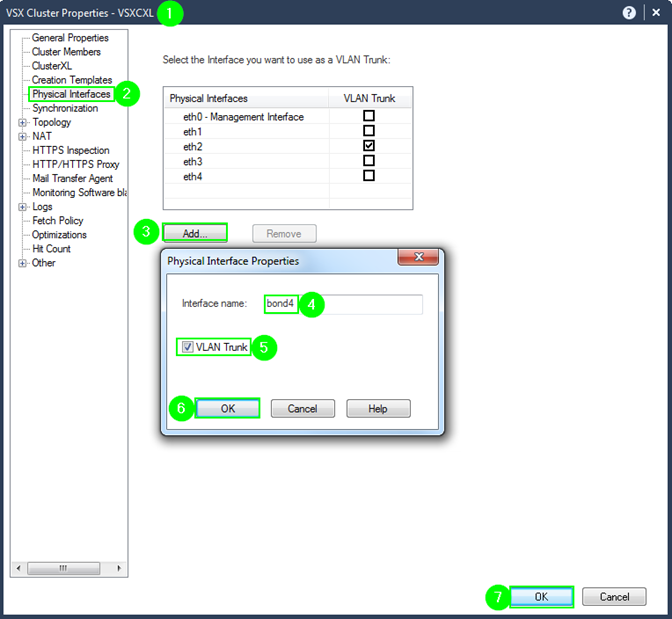
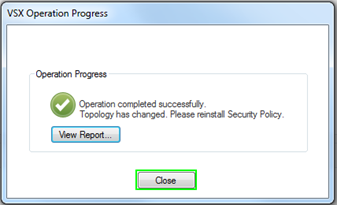
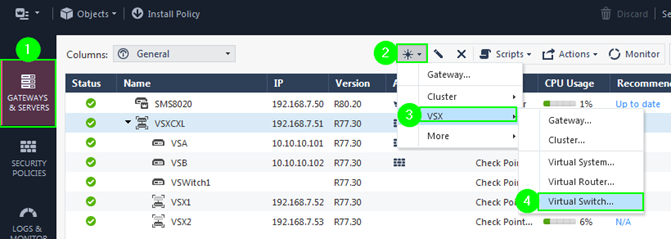
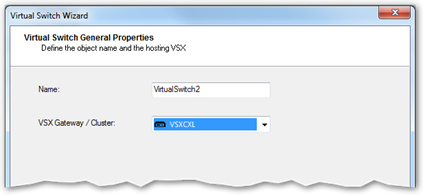
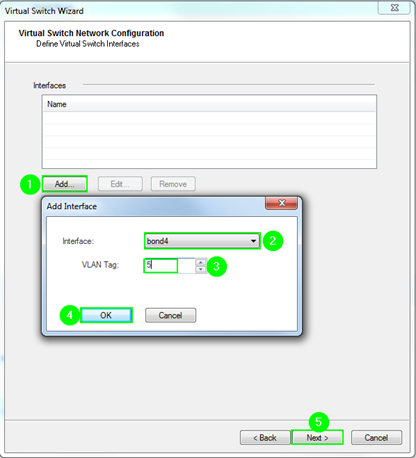

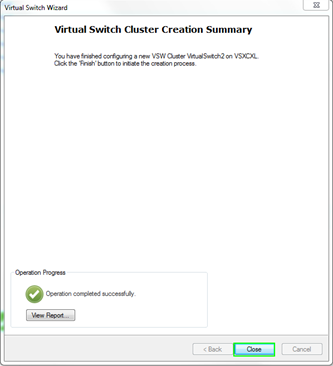
-----------------------------------------------
Phase 3, configure Virtual System
-----------------------------------------------
See Word Document
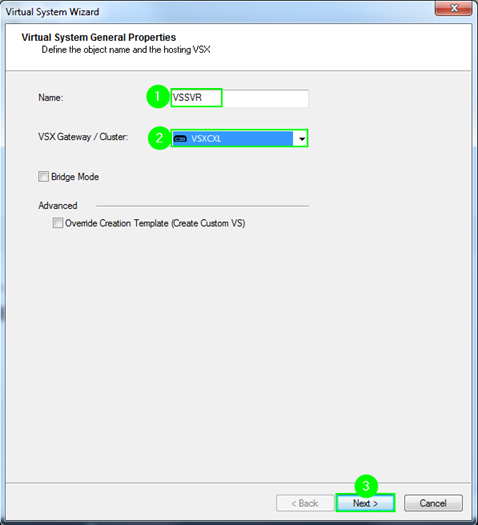
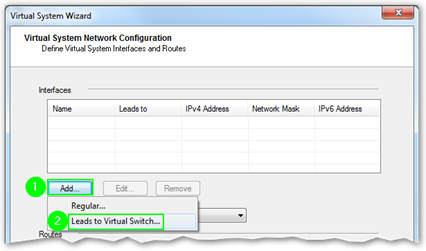
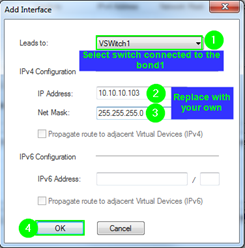

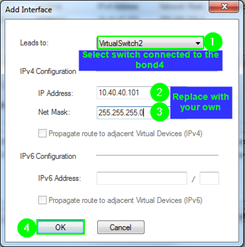
Specify desired “Main IP Address” according to your established convention and add static and/or default route(s) if required:

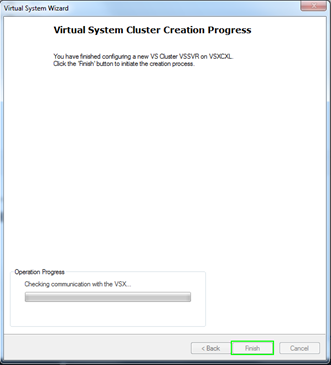
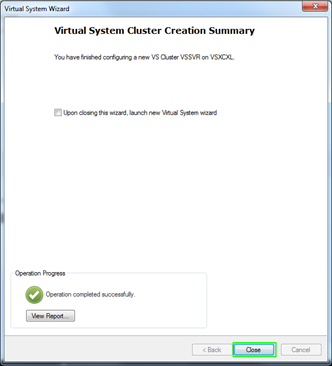

-----------------------------------------------
Phase 4, Assign 2x Weight to the new VS and redistribute load.
This is done in anticipation of the new VS handling disproportionally larger traffic load.
It will force two existing VMs to co-exist on a VSX cluster member different from that handling
this new VS:
-----------------------------------------------
SMS8020> expert
Enter expert password:
Warning! All configurations should be done through clish
You are in expert mode now.
[Expert@SMS8020:0]# vsx_util vsls
******************************************************************************************
* Note: the operation you are about to perform changes the information in the management *
* database. Back up the database before continuing. *
******************************************************************************************
Enter Security Management Server/main Domain Management Server IP address (Hit 'ENTER' for 'localhost'):
Enter Administrator Name: admin
Enter Administrator Password:
Select VSX cluster object name:
1) VSXCXL
Select: 1
VS Load Sharing - Menu
________________________________
1. Display current VS Load sharing configuration
2. Distribute all Virtual Systems so that each cluster member is equally loaded
3. Set all VSes active on one member
4. Manually set priority and weight
5. Import configuration from a file
6. Export configuration to a file
7. Exit
Enter redistribution option (1-7) [1]: 4
Update Virtual System VSLS parameter can be done using one of the following methods:
[m]anually - update single Virtual System weight and priority
[a]utomatic - iterate each and every Virtual System and update their weight
Please select update method (m|a) [m]:a
Please enter new weight for the following Virtual Systems, the default value is the current configured weight.
Enter 's' to stop the update procedure, leaving the remaining Virtual Systems weight unchanged.
Please enter weight for VSA [10]:
Skipping current Virtual system, weight remain unchanged!
Please enter weight for VSB [10]:
Skipping current Virtual system, weight remain unchanged!
Please enter weight for VSSVR [10]: 20
Policy installation is required to apply the configuration. Make sure the cluster
members are up and reachable before continuing.
Save & apply configuration ? (y|n) [y]:y
VS Load Sharing configuration saved successfully...
The virtual system(s) were successfully redistributed
Installing new policy...
Policy installation finished successfully.
VS Load Sharing - Menu
________________________________
1. Display current VS Load sharing configuration
2. Distribute all Virtual Systems so that each cluster member is equally loaded
3. Set all VSes active on one member
4. Manually set priority and weight
5. Import configuration from a file
6. Export configuration to a file
7. Exit
Enter redistribution option (1-7) [1]:
----+---------+-----------+-----------+--------+
VSID| VS name | VSX1 | VSX2 | Weight |
----+---------+-----------+-----------+--------+
2 | VSA | 0 | 1 | 10 |
3 | VSB | 1 | 0 | 10 |
5 | VSSVR | 0 | 1 | 20 |
----+---------+-----------+-----------+--------+
Total weight | 30 | 10 | 40 |
----+---------+-----------+-----------+--------+
Legend:
0 - Highest priority
1 - Lowest priority
VS Load Sharing - Menu
________________________________
1. Display current VS Load sharing configuration
2. Distribute all Virtual Systems so that each cluster member is equally loaded
3. Set all VSes active on one member
4. Manually set priority and weight
5. Import configuration from a file
6. Export configuration to a file
7. Exit
Enter redistribution option (1-7) [1]: 2
Weight assigned to each Virtual System to reflect its relative load
and priority list to determine which cluster member will hold the
Virtual System in active, backup or standby state.
The Virtual System priority list will be changed in such manner that
the total weight is balanced among all cluster members.
Policy installation is required to apply the configuration. Make sure the cluster
members are up and reachable before continuing.
Save & apply configuration ? (y|n) [y]:y
Redistributing the virtual systems...
VS Load Sharing configuration saved successfully...
The virtual system(s) were successfully redistributed
Installing new policy...
Policy installation finished successfully.
VS Load Sharing - Menu
________________________________
1. Display current VS Load sharing configuration
2. Distribute all Virtual Systems so that each cluster member is equally loaded
3. Set all VSes active on one member
4. Manually set priority and weight
5. Import configuration from a file
6. Export configuration to a file
7. Exit
Enter redistribution option (1-7) [1]:
----+---------+-----------+-----------+--------+
VSID| VS name | VSX1 | VSX2 | Weight |
----+---------+-----------+-----------+--------+
2 | VSA | 1 | 0 | 10 |
3 | VSB | 1 | 0 | 10 |
5 | VSSVR | 0 | 1 | 20 |
----+---------+-----------+-----------+--------+
Total weight | 20 | 20 | 40 |
----+---------+-----------+-----------+--------+
Legend:
0 - Highest priority
Phase 5, configure OSPF and other VS-specific parameters on EACH CLUSTER MEMBER
VSX1:0> show virtual-system all
Virtual systems list
VS ID VS NAME
0 0
1 VSX1_VSWitch1
2 VSX1_VSA
3 VSX1_VSB
4 VSX1_VirtualSwitch2
5 VSX1_VSSVR
VSX1:0>
VSX1:0> set virtual-system 5
Context is set to vsid 5
VSX1:5>
VSX1:5> set ospf area backbone off
set instance 5 ospf area backbone off
VSX1:5> set ospf area 0.0.0.77 on
set instance 5 ospf area 0.0.0.77 on
VSX1:5> save config
VSX1:5>
VSX2:0> set virtual-system 5
Context is set to vsid 5
VSX2:5>
VSX2:5> set ospf area backbone off
set instance 5 ospf area backbone off
VSX2:5> set ospf area 0.0.0.77 on
set instance 5 ospf area 0.0.0.77 on
VSX2:5> save config
VSX2:5>
SSH session established prior to the manipulation of the VSX infrastructure remains intact:
Every 2.0s: hostname Sun Nov 18 15:06:44 2018
Mint-LAB-Ext
0 Replies
Leaderboard
Epsum factorial non deposit quid pro quo hic escorol.
| User | Count |
|---|---|
| 19 | |
| 10 | |
| 10 | |
| 10 | |
| 6 | |
| 3 | |
| 2 | |
| 2 | |
| 2 | |
| 1 |
Upcoming Events
Thu 08 Jan 2026 @ 05:00 PM (CET)
AI Security Masters Session 1: How AI is Reshaping Our WorldThu 22 Jan 2026 @ 05:00 PM (CET)
AI Security Masters Session 2: Hacking with AI: The Dark Side of InnovationThu 12 Feb 2026 @ 05:00 PM (CET)
AI Security Masters Session 3: Exposing AI Vulnerabilities: CP<R> Latest Security FindingsThu 26 Feb 2026 @ 05:00 PM (CET)
AI Security Masters Session 4: Powering Prevention: The AI Driving Check Point’s ThreatCloudThu 08 Jan 2026 @ 05:00 PM (CET)
AI Security Masters Session 1: How AI is Reshaping Our WorldThu 22 Jan 2026 @ 05:00 PM (CET)
AI Security Masters Session 2: Hacking with AI: The Dark Side of InnovationThu 26 Feb 2026 @ 05:00 PM (CET)
AI Security Masters Session 4: Powering Prevention: The AI Driving Check Point’s ThreatCloudAbout CheckMates
Learn Check Point
Advanced Learning
YOU DESERVE THE BEST SECURITY
©1994-2025 Check Point Software Technologies Ltd. All rights reserved.
Copyright
Privacy Policy
About Us
UserCenter


